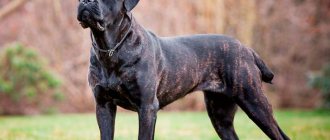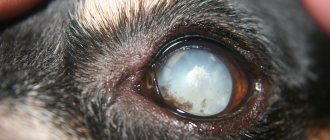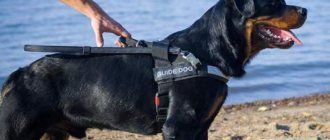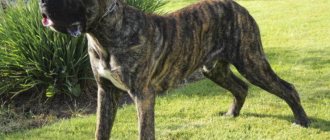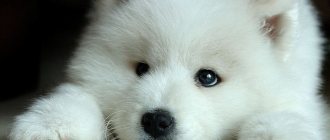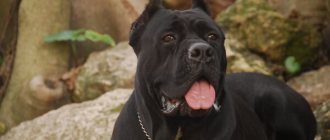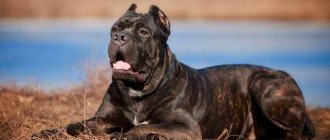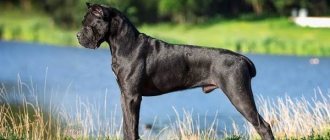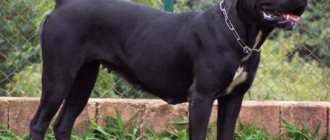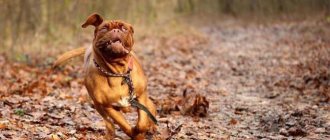Cane Corso can do any job - they can guard the house or protect the owner himself, they can graze livestock, play with small children, and assist in bear hunting. Cane Corso owner reviews are negative - positive ones are described in this article.
History of the Cane Corso breed
The homeland of animals is Italy. In this country, this dog breed is considered a national treasure. There are about a hundred breed nurseries operating there.
The Cane Corso dog breed was first mentioned in the annals of the Roman Empire. There are a number of images depicting representatives of the Roman nobility with large dogs that are similar in appearance to modern Italian mastiffs.
The ancestors of the Cane Corso, like all Molossians, are considered to be the huge and aggressive Tibetan Great Danes. A thousand years BC they appeared in China. Emperors carried out security service at court.
300 years before the birth of Christ, together with the Roman troops, they came to Europe.
The ancient Roman Cane Corsos were distinguished by their large, impressive size and power. Even then they were a popular and expensive breed. They lived and served in the palaces of the Roman nobility. In those days, poor Romans could not afford such dogs.
Throughout their history, Cane Corsos were used for protection, hunting, and entertainment. In the Roman Empire, dogs guarded the palaces of the Roman patricians, drove and guarded herds of cattle, in dog fights and battles with gladiators, and participated in military campaigns. Roman legionnaires released mastiffs in the first wave of the attack. These dogs, after proper training, replaced trained warriors and fought with people on equal terms. Powerful dogs caused great damage to enemy troops and caused panic in their ranks.
Cane Corsos had thick skins. The dogs were wearing collars with spikes and chain mail. In such equipment they became practically invulnerable to enemy weapons. Often, Roman legionnaires attached barrels of burning tar to the backs of four-legged warriors. After that they released them on the enemies.
After the fall of the Roman Empire, dogs remained in demand. People learned to use them to hunt large animals: bears and wild boars. To improve the hunting qualities of the dogs, the blood of aboriginal hunting dogs was added to them.
During the Renaissance, thanks to their fearlessness, these dogs attracted the attention of artists and sculptors, who happily captured their images in works of art.
Over the centuries, Italians have used the Cane Corso for various purposes. Various working qualities were fixed and cultivated in animals. Thanks to this, they are rightly recognized as universal dogs.
By the end of the 19th century, Cane Corsos gained recognition among the common people. Peasants used four-legged helpers to guard property and herd livestock.
During the First and Second World Wars, the number of Italian mastiffs was halved. The breed was on the verge of extinction. After the wars, Italians had no time for four-legged pets.
Perhaps the world would never have known about the noble Cane Corso breed if there had not been an enthusiast, Professor Giovanni Nizza. In 1973, he and his like-minded people began restoring the breed. We collected the remaining Cane Corso from all over Italy and created the breed nursery “Del Antico Cerberus”.
In 1988, the Italian Kennel Club established the "Open Book of the Breed", which over the next few years registered approximately 500 dogs that met the standard. In 1994, the Italian Kennel Club officially approved breed standards. Just two years later, in October 1996, the breed was recognized by the Fédération Cynologique Internationale (FCI). By the beginning of the 21st century, there were already about 3 thousand representatives of the breed in Italy.
Cane Corso in Russia
In 1994, the first representatives of the breed were brought to our country. These were puppies from the famous kennel “Del Antico Cerberus”. “Italians” appealed to Russian dog lovers. The breed quickly gained popularity.
How is the name of the breed explained?
There is no consensus on this issue. There is still some debate going on. There are many versions.
According to one of them, the name of the breed is associated with the Corsi family. The ancient coat of arms of this family depicts a dog, in appearance exactly like the modern Italian mastiff. Many experts are skeptical about this version. The fact is that the name of the breed could have appeared much earlier than the family coat of arms. A noble family depicted a mighty dog on its coat of arms due to the consonance of the surname and the name of the breed.
Thanks to the German naturalist Konrad Gesner, the name of the breed is associated with Corsica. In 1551, a scientist visited the island and described Corsican dogs in his work. Their description fits the modern Cane Corso.
A number of researchers suggest that the name of the dog breed comes from the ancient Greek word “kortos”. It translates as “territory surrounded by a fence.” Other scientists disagree with them. The name of the breed is associated with the Latin word “cohors”, which translates as “guardian”.
According to another version, the name of the breed comes from the Italian word “corsıero” - “war horse”. During the Roman Empire, these dogs were valued no less than purebred horses.
Basic moments
Modern Cane Corsos are descendants of gladiator dogs; they exude natural strength and greatness. They look stern and can even inspire fear, but in fact they become true friends for their owners and remain so throughout their lives. Being the fourteenth breed bred in Italy, the Cane Corso is the pride and national treasure of this country. The character of the dogs surprisingly intertwined the dedication of shepherds and the courage of fighting breeds, and also reflected the lively temperament of the Italians themselves.
Cane Corsos are sensitive and intuitive; they are ready to protect their owner and his family at any time and in any situation, which makes them unrivaled guards. If a dog of this breed lives in your house, there is no need for alarm systems. They will not greet a thief who breaks into the house with aggression, which is different from other guard dogs, but the burglar will very much regret meeting a native of the sunny Apennines. The Cane Corso reserves an aggressive reaction as a last resort, when it feels that a real threat is looming over the owner and his property.
Features of the Cane Corso
The Cane Corso breed is one of the most expensive and prestigious in the world. The reason is that dogs have excellent working qualities. At the same time they cope with the duties of a security guard and bodyguard. Like the Turkmen Alabai and the Caucasian Shepherd Dog, they know and guard the boundaries of their territory. Brave. They never give in to danger. The Italian Mastiff has high intelligence. Able to not only carry out the owner’s commands. If necessary, he evaluates the situation and makes a decision.
Thanks to these qualities, the Cane Corso quickly gained respect throughout the world. Dogs are actively exported from Italy to the USA, Canada and European countries. There, as in their homeland, they are used for police service, security of expensive shops and restaurants, apartments and cottages. It's no secret that the Cane Corso is the favorite breed of Italian and American mafiosi.
Interesting fact
Cane Corso has repeatedly appeared in Hollywood films. However, due to their menacing appearance, they only get negative roles.
Description of the breed
Cane Corso combines beauty and nobility. These are large dogs with prominent muscles. They have an intelligent and insightful look. Incomparable facial expressions. It is impossible to pass by and not notice such a dog. He inspires admiration and awe.
Cane Corso sizes
Height at the withers ranges from 60 to 70 cm. Cane Corso weight is 40 – 55 kg.
Head
Wide and massive. The transition from forehead to muzzle is clearly defined. The muzzle is square and short. The jaws are rectangular in shape and wide. The nose is black. The nostrils are large.
Eyes
Medium size. Almost oval in shape. Preferably dark color. Must be in harmony with the color of the coat.
Ears
Wide, triangular in shape at the base. Hanging. For a long time it was customary to stop them. Currently they are left natural. This is due to the laws in force in the European Union.
Frame
Slightly stretched format. The neck is powerful. The chest is convex. The withers are higher than the croup. The back is straight and muscular. The croup is wide, long, slightly sloping.
Limbs
Powerful. The front legs are round and more compact than the hind legs.
Tail
Thick at the base. Highly placed. Initially, it was decided to stop it at the level of the 4th vertebra. Currently it is left natural. The tail should not curl behind the back in a ring.
Coat
The coat is short and very thick. The undercoat is thin.
Color
Black, gray of all shades (from light to lead and blue), red (from light to reddish), brindle. Brindle and beige have a black or gray mask on their face.
Black Cane Corsos are very popular in Russia. Demand creates supply. Therefore, Russian breeders select pairs that produce predominantly black-colored puppies. This explains why red, beige, and blue dogs are not often seen at shows. In the homeland of the breed, Italy, the situation is different. Fans of the breed prefer the Cane Corso brindle color.
Cane Corso character
Devotion, security qualities, intelligence, fearlessness - these are the positive traits of the modern “Italian”.
The Cane Corso is a one-owner dog. He will treat all family members with respect, but only one will be considered the main one. Emotional contact with the owner is important for a dog. He should feel needed and loved.
Despite its threatening appearance, the breed is not susceptible to attacks of sudden, unreasonable aggression. They never attack anyone without a reason.
Dogs divide all people into friends and foes. They treat strangers neutrally, but with distrust. They behave peacefully towards them. However, if a stranger approaches the owner or family members, the dog will not let him out of his sight. He will control every movement, every gesture of an outsider.
The character of the Cane Corso is distinguished by restraint. They never bark without a reason.
Outwardly, these powerful dogs look imposing and leisurely. Do not be mistaken - the impression is deceptive. If the corse senses a danger looming over the owner or his property, it will instantly transform and come to the defense. The consequences can be unpredictable for the offender. Therefore, you should never tease or provoke your dog.
The Cane Corso has a guardian instinct at the genetic level. By the age of one year, these dogs, even without special training, protect the property of their owners.
These pets are distinguished by their peculiar hospitality. They can let a guest into the apartment or into the yard. However, he will not be allowed to leave without the owner’s knowledge.
They get along great with children. They show patience when communicating with them. If the child is too annoying, the dog will turn around and leave. Never shows aggression or ferocity.
Italian Mastiffs get along well with cats, parrots, and other dogs that live in the family. They are treated as the owner's property. They behave friendly towards them. Protect if necessary. They do this not only because they consider them the owner’s property. Protecting the weak is in their blood.
The Cane Corso is a dominant breed. If the owner is weak-willed and lacks knowledge and experience, the dog will try to take the position of leader in the family. It will be difficult to put the pet in its place. Therefore, it is not recommended to have an Italian Mastiff as your first dog. They are not suitable for beginner dog owners.
To say that Italian Mastiffs do not show aggression at all is misleading. There are some aggressive individuals. During walks, they rush at their relatives, attack people, and terrorize their owners at home. Experts say they are not born this way. This is how pets behave when their owners made serious mistakes when raising them. As a result, we lost contact with the animal. With proper upbringing, the dog grows up obedient, calm and controllable.
Character and behavioral characteristics
The Cane Corso is an intelligent dog that demands respect. She will not tolerate cruel treatment and aggression in her direction. The animal is balanced, does not have increased aggressiveness, which means it will never attack, much less bite. However, you should not touch the dog; if it realizes that it is being invaded without permission, it may become angry.
How to treat children
These dogs have a positive attitude towards children. The main role for a pet is protection. Therefore, they can act not only as playmates for children, but also as their faithful guards.
What sets the Cane Corso apart from many dogs is that they are aware of their actions, strength and power. This means that when playing with children, the dog will not frighten the child, will not knock him down or cause harm. However, before games and other activities, the child should be explained that the dog requires affection and respect.
Behavior at home
If there are other pets living in the house, then there is no need to fear for their lives. The Cane Corso will even make friends with a parrot. In the house the dog behaves calmly and understands perfectly who is the boss in the house. However, it is worth introducing boundaries for the animal. If from puppyhood he was allowed to sleep, play and spend time in the apartment, then he will do this as an adult, and this is not a small dog that can cause inconvenience. But if the dog knows its place, there will be no problems living in the house. Moreover, in winter he cannot live on the street because of his light undercoat, and he also needs frequent communication with his owner.
Behavior on the street
On the street, people will probably give a wide berth to a person accompanying a Cane Corso. The menacing appearance of the dog frightens others who are not even aware of the kindness and good manners of the dog. However, when going out with your pet on the street where there are people, it is better to put a muzzle on the dog. Although he is smart and understanding, if he senses danger from the owner’s interlocutor, he may not contain his anxiety and frighten the person.
Important! Excessive aggression is not inherent in the Cane Corso and is considered a defect of the breed.
Attitude towards strangers
The pet is attached and devoted to its owner, for his sake he is ready to do anything, in the literal sense. Therefore, strangers should behave carefully around this dog. Sudden movements should be avoided; the dog will not attack a person for this, but with his growling he will show that this is not worth doing.
The Cane Corso is far from a stupid animal by nature and will not accept treats from the hands of a stranger, and will never follow a stranger. This breed knows how to divide people into “us” and “stranger”. She has a well-developed intuition and, if a stranger poses a danger to the owner, the dog will clearly show its displeasure.
Owner protection and home security
The Cane Corso is a really smart and kind animal, without any pronounced aggression, but this does not prevent him from acting as a guard for his owner and even the whole house.
These dogs sense not just danger, but even its approach. They react to intruders almost instantly, and thanks to their iron grip they will not release the enemy until the owner arrives. Dogs do not like uninvited guests, so it is better for them not to enter the territory without the owner of the house.
Education and training of the Cane Corso
Raising a pet begins from the first minute it appears in the house. Gradually explain to the puppy the rules of behavior in the family. Be consistent. Don't yell at him. Do not use physical force, even if he has done something wrong. Otherwise, you can lead your pet to a nervous breakdown. It is important for the Italian Mastiff to understand the owner, predict his thoughts, and feel needed. Then he will serve him faithfully all his life.
Show the baby his place. Lay him a soft bedding. The little puppy is very cute, you want to take him to your bed. However, you shouldn't do this. Don't forget that this charming little lump will soon turn into a large and powerful dog. Then it will be difficult to wean him off the master's bed. Every time you send your pet out of bed, the dog will feel insulted.
Purchase toys for your puppy in advance. They must be of good quality, durable and of the right size. The baby should only play with them, and not with the owners’ things. Otherwise, left without your control, the pet may chew the legs of chairs or the heels of shoes.
Never allow your pet to become aggressive during play. If your puppy bites you, stop playing. Then the baby will understand that biting is not allowed. He will learn a simple truth: “If you want to play, give up bad habits.”
At three months, the pet should know its name, master the commands “eat”, “place”, “come to me”.
Get your puppy used to a collar and leash. This is not difficult to do. First, you need to put the collar on your baby for a short time. If he doesn't try to remove the ammunition, praise him. Give them a treat. After the puppy gets used to the collar and leash, you can go for a walk.
The street is an important place for puppy socialization. At first, a four-legged baby may be afraid of an unfamiliar environment. But gradually walks will begin to give him pleasure. Visit crowded places and noisy streets. Increase your walking time little by little. If your little Cane Corso behaves well, do not spare him praise and treat him with a treat. These simple techniques will lift your puppy's spirits and give him confidence.
The baby will benefit from meeting his relatives, but only if the dogs treat him calmly, without aggression.
The Cane Corso is a serious dog that needs training. You can practice it yourself, but only if you have experience and knowledge. If they are not there, you need to contact a specialist. Do not give your puppy up to even the most advanced dog handler. Otherwise, you risk finding yourself in a situation where the dog will obey him and not you. Contact the club, sign up for group or individual classes. Complete a general training course (“OCD”). It is worth the effort to get an obedient and problem-free dog.
Care and maintenance
Caring for a Cane Corso does not require much effort. The wool must be combed with a brush or a special mitten 1-2 times a week. If you don't do this, it will spill onto the floor. Cause inconvenience to owners.
You should wash your dog as needed. To do this, use special high-quality shampoos.
Don't forget to check your eyes and ears. Make sure there is no redness or purulent discharge. Dirt and wax should be removed with swabs soaked in a special veterinary lotion.
Check the condition of the claws regularly. If they are very branched, trim them with a nail clipper.
A description of the Cane Corso would be incomplete without mentioning some of the characteristics of the breed.
- Some owners complain that the dog leaves drool on furniture, wallpaper and clothes. This is how this dog works. This is his specialty. You need to know about it and be prepared for it. If this is not an acceptable option for you, choose a pet of a different breed.
- They snore and sniffle in their sleep. This innocent feature often irritates “impressionable” owners.
Walk
The dogs are very active, so they need long walks. Fifteen minutes is not enough. You need to walk with an Italian 2 times a day for at least 3 hours in total. The walk should be complete. Include movement on a leash and games with the owner, if possible, communication with fellow tribesmen, elements of training. If the dog is poorly walked, it will destroy the apartment. There will be nothing to scold her for. She needs to release physical energy.
Feeding
There are two options for feeding your dog: natural products or dry food. The owner decides which one to choose.
Some supporters of natural nutrition argue that 70-80% of an animal's diet should consist of meat products. Many veterinarians strongly disagree with this statement. Excess protein causes kidney problems. Lack of protein is also harmful to the dog's body. A natural diet should include meat and offal, fish, vegetables, cereals (rice and buckwheat). Cane Corso owners often encounter a problem - their dogs develop allergies. Then you should choose industrial food that is suitable for the dog. It is desirable that it be premium or super premium
Cane Corsos are prone to gastric volvulus. To prevent the development of this disease, you need to feed your pet in small portions. If he is not eating enough, you should increase the number of feedings. Immediately after eating, you should not go for a walk with him. Let your pet rest and let the pieces settle in his gastrointestinal tract.
Diet
Cane Corso can be fed the following foods:
- Boiled beef.
- Sea fish and seafood.
- Washed vegetables and fruits (zucchini, pumpkin, eggplant, cabbage, chopped apples).
- Porridge (rice or buckwheat).
- Sunflower oil (1-2 tablespoons).
- Ground flaxseeds.
To clean the dog’s mouth, you can give a little crackers, cartilage or “sugar” seeds. The animal can be fed premium dry formulas. For a large dog, food containing the following ingredients is suitable:
- Animal proteins.
- Fats.
- Plant fiber.
- Minerals.
- Vitamin supplements.
- Yeast.
- Flour from various grain crops.
- Lutein, glucosamine and chondroitin.
The animal must be fed strictly according to a schedule (an adult dog should be fed twice a day). In the evening, you can give natural foods, and in the morning, pour dry food into a bowl.
Popular questions about the breed
How many years do they live
The lifespan of dogs depends on many factors. Among them: nutrition and care, quality of veterinary care, genetics, ecology. The average life expectancy of a Cane Corso is short - 8-9 years. Don't despair! Among the representatives of this breed there are long-livers. They live up to 11-12 years. Perhaps your pet will be one of them.
Are they suitable for living in apartments?
Cane Corso are not adapted to the Russian climate. Due to their short coat and thin undercoat, they freeze in winter. Therefore, they are not suitable for outdoor use. But they feel great in country houses and apartments.
Despite their large size, corsas are practically invisible even in small rooms. They do not fuss, do not hover under their owners’ feet, trying to attract their attention. They lie on the mat and doze. However, they do not let down their vigilance. Even in this state, he is aware of everything that is happening in the house.
How to feel about loneliness
Cane Corsos are people-oriented. They need his presence. Loneliness is very difficult to bear. Therefore, they are not suitable for those people who are at work all day. Of course, a Corse can sit at home for a day or two, alone, without its owner... But when this turns into a system, the dog can chew the door and destroy the apartment. In this way he drives away melancholy.
What breed of dog is best to get?
- What breed of dog is best to get? It is necessary to choose a dog, taking into account not only your wishes, but also the tasks that it will have to perform. It should be noted that most service and guard dog breeds are universal, that is, they can perform various functions assigned to them.
- A competent owner and a good trainer can train any dog. However, some breeds are guards by vocation, while others perform this work out of necessity. In addition, you need to realistically assess your capabilities. After all, not every person can raise, for example, a fighting dog.
- Almost all guard dogs have a tough character, a desire for dominance and the ability to act independently. Therefore, some breeds should be trained by experienced dog handlers.
- guard dog breeds can be used as a bodyguard since their desire to protect their owner is based on love and devotion to him.
The following dog breeds are excellent for protecting humans:
- German Shepherd
- Rottweiler
- Doberman
- Boxer
- Cane Corso
If you are choosing which breed of dog is best to have at home or which breed of dog is best to have in an apartment, you must take into account the conditions in which the animal will live. Thus, dogs guarding a private home are usually kept on the street, in a kennel or free enclosure.
A dog for human protection
Therefore, such an animal must have the following basic qualities:
- Large sizes.
- Thick hair.
- Endurance.
- Innate distrust of strangers.
- Tendency to make independent decisions.
- The ability to tolerate loneliness normally.
Alabais and German shepherds are perfect for guarding private homes.
- Owners of all guard dogs should be aware that these dog breeds should not be kept on a leash. This can only be a temporary measure, for example, if guests come.
- Restricting the freedom of an active and energetic guard dog can lead to mental disorders. And the animal can become a real threat.
To guard an apartment, as a rule, dogs are used, which are characterized by the following qualities:
- Cleanliness.
- Short hair.
- No tendency to excessive shedding or drooling.
- Obedience and lack of hyperactivity.
Dobermans, Rottweilers, Boxers, and Cane Corso are considered the best apartment guards.
And breeds that differ in the following traits are suitable for the role of a companion dog:
- Developed intelligence.
- Easy to learn.
- Devotion.
- Friendliness.
- People and family oriented.
For friendship and communication, good-natured Labradors or versatile German Shepherds are most often chosen.
An excellent companion
A dog is a person’s faithful friend and helper. But in the hands of an inept or aggressive owner, it can become an uncontrollable, ferocious animal, dangerous both to others and to the owner himself and his family members. Therefore, when you decide to get a puppy, carefully read the characteristics of the breed and the requirements for its maintenance.
You can find out about other breeds here:
- Dogs for protection: rating, review of the best breeds
- Doberman or German Shepherd - which dog is better, stronger, smarter: comparison of breeds
- The Papillon dog is a multi-colored continental toy spaniel with butterfly ears.
- Mexican hairless dog of the Xoloitzcuintle breed: standard, description, appearance
- Hungarian Komondor Shepherd - an intelligent and unusual dog: types, description, standard, photo
What kind of dog do you have or maybe you are looking at breeds? Tell us about it in the comments. Don't forget to bookmark us and come back often. We are very glad to see you!
Cane Corso diseases
The characteristics of the breed will be incomplete if we do not touch upon the topic of health. Cane Corsos are prone to a number of diseases. Some of them can be transmitted at the genetic level.
- Hip dysplasia. This is the scourge of all large breeds. The disease is inherited. Therefore, responsible breeders examine dogs for a tendency to this disease - they take pictures of the joints. Only after a negative result are they allowed to breed. Dysplasia can develop with age. Causes lameness and impaired movement in the pet.
- Inversion and eversion of the eyelids. Solved by surgery. Symptoms: constant lacrimation, inflammation of the mucous membrane of the eyes.
- Gastric volvulus. The reason is weak ligaments that support the stomach.
- Prone to allergies.
- As Cane Corsos get older, they can develop heart disease.
Advantages and disadvantages
The advantages of the Cane Corso can be considered:
- Unusual exterior.
- Loyalty and devotion to the owner.
- Stable psyche.
- Good health.
- Endurance and agility.
The following factors can be considered disadvantages of the breed:
- High cost of maintenance.
- Increased salivation.
- Snoring during sleep.
- Large dimensions.
- Allergic reaction to certain foods.
- Poor tolerance to low temperatures.
- Short life expectancy (9–10 years).
Where to buy a Cane Corso
Never buy a puppy from dubious sellers. Of course, you can buy a four-legged baby from them cheaply. However, don't be surprised if your puppy turns out to be a mixed breed. A stingy owner may face another problem. If the bitch was poorly fed during pregnancy, the puppies will have poor health.
It is safer to purchase a pet from a specialist nursery with a good reputation.
If parents participate in exhibitions and have titles, this is a good sign. You can be sure that they have a stable psyche. Most likely they have a friendly nature, otherwise they would be disqualified in the ring. You can guarantee that throughout their lives they were well fed and looked after. They were under the supervision of veterinarians. Experienced breeders carefully select pairs to ensure that the puppies turn out healthy and beautiful.
At the nursery you are guaranteed to receive documents for the puppy. You can always consult with the breeder if you have any questions related to raising or raising a pet.
Whom to choose? Bitch or dog
Males are more independent and straightforward than females. Larger and more powerful in size. Their weight is 45-55 kg with a height at the withers of 64-70. Bitches weigh 40-45 kg, height 60-65cm. Boys have pronounced “sexual” behavior. They need stricter education and constant supervision on the street. More pugnacious than bitches. They are prone to “spree” and “escapes” if a “lady in heat” appears in the neighborhood.
Bitches are softer, more obedient and cunning. As a rule, girls are attached to their owner and do not require special control when walking. The exception is during estrus.
How to choose a puppy
Clearly define for yourself the purpose for which you are buying a dog. Tell the breeder about this. He will select a baby for you according to your wishes and financial capabilities.
- If you take a Corsa as a pet and do not intend to attend exhibitions or engage in breeding, then a “pet-class” baby will do. These are dogs that have slight deviations from the standard. This does not affect your health in any way.
- If you are going to participate in exhibitions, or want your dog to participate in breeding, choose a “breed-class” puppy. They are as close as possible to the breed standard, but have minor flaws.
- If you dream of raising a “star” of canine exhibitions, splurge on a “show class”. These dogs fully comply with the breed standard.
Before you take your baby home, examine him.
- The puppy must be developed according to its age.
- Must be well-fed, but not thin.
- The coat should be clean, shiny, without bald spots.
- The skin is clean, without redness or scratching.
- Eyes without purulent discharge. The eyelids should not be turned out.
- Ears are clean, without redness or unpleasant odor.
- The paws are thick and straight. A small Cane Corso should not limp. His movements should be light and free.
- A Cane Corso puppy should have a good appetite.
- Be cheerful and playful.
- Show no signs of cowardice.
What questions to ask the breeder before taking your puppy home?
- When and what vaccinations were the Cane Corso given? When is the next one due?
- What kind of food does the baby eat?
- When can you take your puppy outside?
- Is it possible to contact the breeder for advice on feeding and rearing issues?
If the breeder does not intend to care for his puppies in the future and communicate with their owners, it is better to look for another kennel.
How much does a Cane Corso cost?
The cost of puppies consists of several components: the title of the parents, the type of mating (exit or local), and the geographical location of the nursery.
In large cities, Italian Cane Corso puppies will cost more than in small towns. The price does not always depend on the quality of four-legged babies. Often due to demand for them. In large cities it is higher.
For pet-class puppies you will have to pay 20 – 35 thousand. Brid – 35 – 65. Show – from 65 and above.
How to choose a puppy
Before making a choice, study the breed standard. It would be a good idea to attend solo exhibitions: this will allow you to learn about the Cane Corso, as they say, first hand and choose the parents of the puppy. Be sure to take a closer look at the mother’s appearance and behavior. Whatever the purpose for which you purchase a puppy, buy it not from your own hands, but from breeders or from a kennel. This will allow you to be calm regarding the purity of the breed, the physical and mental health of the pet. The baby should be well-fed and very active. Ask the breeder about the character of the puppy you have chosen, ask them to focus on the peculiarities of its behavior. When purchasing, you must be given a veterinary passport.
